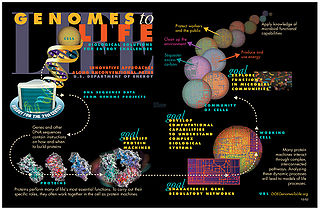
Computational biology refers to the use of data analysis, mathematical modeling and computational simulations to understand biological systems and relationships. An intersection of computer science, biology, and big data, the field also has foundations in applied mathematics, chemistry, and genetics. It differs from biological computing, a subfield of computer engineering which uses bioengineering to build computers.
In computer science, an object can be a variable, a data structure, a function, or a method. As regions of memory, they contain value and are referenced by identifiers.
Software design is the process by which an agent creates a specification of a software artifact intended to accomplish goals, using a set of primitive components and subject to constraints. The term is sometimes used broadly to refer to "all the activity involved in conceptualizing, framing, implementing, commissioning, and ultimately modifying" the software, or more specifically "the activity following requirements specification and before programming, as ... [in] a stylized software engineering process."

Theoretical computer science (TCS) is a subset of general computer science and mathematics that focuses on mathematical aspects of computer science such as the theory of computation, lambda calculus, and type theory.

Systems biology is the computational and mathematical analysis and modeling of complex biological systems. It is a biology-based interdisciplinary field of study that focuses on complex interactions within biological systems, using a holistic approach to biological research.
Broadly speaking, modularity is the degree to which a system's components may be separated and recombined, often with the benefit of flexibility and variety in use. The concept of modularity is used primarily to reduce complexity by breaking a system into varying degrees of interdependence and independence across and "hide the complexity of each part behind an abstraction and interface". However, the concept of modularity can be extended to multiple disciplines, each with their own nuances. Despite these nuances, consistent themes concerning modular systems can be identified.

Mathematical and theoretical biology, or biomathematics, is a branch of biology which employs theoretical analysis, mathematical models and abstractions of the living organisms to investigate the principles that govern the structure, development and behavior of the systems, as opposed to experimental biology which deals with the conduction of experiments to prove and validate the scientific theories. The field is sometimes called mathematical biology or biomathematics to stress the mathematical side, or theoretical biology to stress the biological side. Theoretical biology focuses more on the development of theoretical principles for biology while mathematical biology focuses on the use of mathematical tools to study biological systems, even though the two terms are sometimes interchanged.

Ehud Shapiro is a multi-disciplinary scientist, artist, entrepreneur and Professor of Computer Science and Biology at the Weizmann Institute of Science. With international reputation, he made fundamental contributions to many scientific disciplines. Shapiro was also an Internet pioneer, a successful Internet entrepreneur, and a pioneer and proponent of E-democracy. Shapiro is the founder of the Ba Rock Band and conceived its original artistic program. He is a winner of two ERC Advanced Grants.
Biorobotics is an interdisciplinary science that combines the fields of biomedical engineering, cybernetics, and robotics to develop new technologies that integrate biology with mechanical systems to develop more efficient communication, alter genetic information, and create machines that imitate biological systems.

CellML is an XML based markup language for describing mathematical models. Although it could theoretically describe any mathematical model, it was originally created with the Physiome Project in mind, and hence used primarily to describe models relevant to the field of biology. This is reflected in its name CellML, although this is simply a name, not an abbreviation. CellML is growing in popularity as a portable description format for computational models, and groups throughout the world are using CellML for modelling or developing software tools based on CellML. CellML is similar to Systems Biology Markup Language SBML but provides greater scope for model modularity and reuse, and is not specific to descriptions of biochemistry.
Modelling biological systems is a significant task of systems biology and mathematical biology. Computational systems biology aims to develop and use efficient algorithms, data structures, visualization and communication tools with the goal of computer modelling of biological systems. It involves the use of computer simulations of biological systems, including cellular subsystems, to both analyze and visualize the complex connections of these cellular processes.

The Biocomplexity Institute of Virginia Tech is a research organization specializing in bioinformatics, computational biology, and systems biology. The institute has more than 250 personnel, including over 50 tenured and research faculty. Research at the institute involves collaboration in diverse disciplines such as mathematics, computer science, biology, plant pathology, biochemistry, systems biology, statistics, economics, synthetic biology and medicine. The institute develops -omic and bioinformatic tools and databases that can be applied to the study of human, animal and plant diseases as well as the discovery of new vaccine, drug and diagnostic targets.
Concurrent computing is a form of computing in which several computations are executed concurrently—during overlapping time periods—instead of sequentially—with one completing before the next starts.
Modularity refers to the ability of a system to organize discrete, individual units that can overall increase the efficiency of network activity and, in a biological sense, facilitates selective forces upon the network. Modularity is observed in all model systems, and can be studied at nearly every scale of biological organization, from molecular interactions all the way up to the whole organism.
The Systems Biology Markup Language (SBML) is a representation format, based on XML, for communicating and storing computational models of biological processes. It is a free and open standard with widespread software support and a community of users and developers. SBML can represent many different classes of biological phenomena, including metabolic networks, cell signaling pathways, regulatory networks, infectious diseases, and many others. It has been proposed as a standard for representing computational models in systems biology today.

A biological network is a method of representing systems as complex sets of binary interactions or relations between various biological entities. In general, networks or graphs are used to capture relationships between entities or objects. A typical graphing representation consists of a set of nodes connected by edges.

A cellular model is a mathematical model of aspects of a biological cell, for the purposes of in silico research.
GenoCAD is one of the earliest computer assisted design tools for synthetic biology. The software is a bioinformatics tool developed and maintained by GenoFAB, Inc.. GenoCAD facilitates the design of protein expression vectors, artificial gene networks and other genetic constructs for genetic engineering and is based on the theory of formal languages.
The following outline is provided as an overview of and topical guide to formal science:
Radhika Nagpal is an American computer scientist and researcher in the fields of self-organising computer systems, biologically-inspired robotics, and biological multi-agent systems. She is the Fred Kavli Professor of Computer Science at Harvard University and the Harvard School of Engineering and Applied Sciences. She is also a Core Faculty Member of the Harvard Wyss Institute for Biologically Inspired Engineering. In 2017, Nagpal co-founded a robotics company under the name of Root Robotics. This educational company works to create many different opportunities for those unable to code to learn how.







